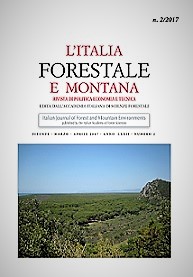Published
2017-06-05
Keywords
- forest landscape,
- land use changes,
- coastal pine forests,
- forest dynamics,
- forest management,
- eco-system services
...More
Less
Abstract
In Tuscany (central Italy), Italian stone pine forests (Pinus pinea L.) have characterized the coastal landscape for about five centuries. Coastal stone pine forests provide many goods and services, such as dune stability, protection of arable lands, biodiversity, wildlife habitat, space for tourism and recreation, landscape perception and aesthetic, wood and non-wood forest products. Since the middle of the 20th century this anthropogenic landscape has been diminishing due to changes in forest dynamics and land use. Nowadays, the quality and quantity of goods and services provided by coastal pinewoods are influenced by the adopted management styles and by decision-making factors which depend on temporary socio-economic needs that often veer from sustainable forest management criteria. The objectives of this study were: (i) to map the current distribution of stone pine forests along the Tuscan coast, (ii) to analyze land use and land cover changes between 1954 and 2010, and (iii) to describe the structure and principal dynamics of stone pine forests in this area. Results show that in 2010, stone pine forests amounted to 10 660 ha. Land use changes along the Tuscan coast reflect the trends reported on a national scale: urbanization, abandonment of agricultural areas, and expansion of forested areas. Pure stone pine forests have contracted between 1954 and 2010 while the frequency of mixed stone pine-broadleaf forests has grown as a result of successional dynamics, which have progressively led to a transformation of the coastal landscape. Results are discussed with the intention of providing knowledge to support management of the forest landscape along the Tyrrhenian coast


